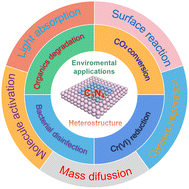Emerging heterostructured C3N4 photocatalysts for photocatalytic environmental pollutant elimination and sterilization
Abstract
Photocatalysis is deemed a highly prominent technology to solve environmental problems such as pollution, CO2 emission and bacterial contamination. As an important photocatalyst, g-C3N4 has attracted a great amount of attention in environmental remediation owing to its good stability, excellent light response, low cost and environmentally friendly properties. However, the pristine g-C3N4 photocatalyst generally suffers from serious photoinduced charge carrier recombination, poor surface active sites, and insufficient visible light harvesting, thereby leading to unsatisfactory photocatalytic performance. Heterostructured C3N4 photocatalysts have recently become a research focus in environmental fields thanks to their fast photoexcited electron–hole pair dissociation, broadened visible light response range, and sufficient photoredox capability. Herein, we critically review the up-to-date developments of heterostructured C3N4 photocatalysts in organic pollutant elimination, heavy metal ion reduction, CO2 conversion and bacterial inactivation. Meanwhile, the strategies for constructing efficient C3N4 based heterostructures with enhanced environmental photocatalytic capability are thoroughly described, which should help readers to quickly acquire in-depth knowledge and to inspire new concepts in heterostructure engineering. Finally, the challenges and opportunities in fabricating heterostructured C3N4 photocatalysts for large-scale and commercial applications are discussed to give a clear study direction in this field.

- This article is part of the themed collection: 2023 Inorganic Chemistry Frontiers Review-type Articles


 Please wait while we load your content...
Please wait while we load your content...